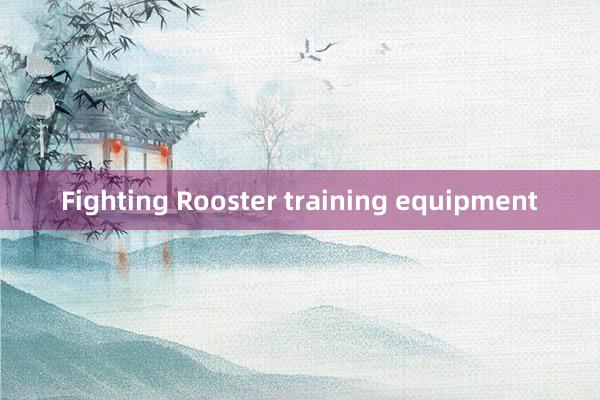
Fighting Rooster Training Equipment: Essential Tools for Optimal Performance
Training a fighting rooster is a centuries-old practice, steeped in tradition and skill. For roosters to perform at their peak, it’s essential that they receive the right training, which includes the use of specialized equipment. Properly preparing a rooster not only ensures better performance in the ring but also promotes the health and well-being of the bird. In this article, we will explore the key pieces of equipment used in fighting rooster training and how they contribute to the development of strong, agile, and well-conditioned birds.
1. Training Pen or Cage
A proper training pen or cage is essential for housing and managing a rooster during training periods. These pens are usually large enough to allow the bird to move freely but confined enough to control its environment. The goal is to simulate the conditions of a fight while minimizing the risk of injury. The rooster will spend significant time here developing its strength, agility, and endurance. Additionally, these enclosures can be customized with different surfaces (such as sand or gravel) to help strengthen the rooster's legs and improve its footing.
2. Harnesses and Jump Stands
One of the most effective tools in rooster training is the use of a harness and jump stand. These are designed to increase a bird’s cardiovascular fitness and leg strength. A harness is securely fastened around the rooster's body, and the bird is encouraged to jump onto a specially designed stand. Over time, this repetitive jumping builds muscle and endurance, crucial for both offensive and defensive maneuvers in the ring. The harness also keeps the bird balanced while ensuring that it works both its upper and lower body equally.
3. Weights and Leg Bands
Another critical component of fighting rooster training involves the use of leg weights and bands. Small weights are attached to the bird's legs to improve its strength and speed. By training with these additional loads, the rooster’s legs become stronger, enhancing both the power and speed of its strikes. The weights should be carefully adjusted according to the bird’s size and fitness level to prevent strain or injury. These weights also mimic the sensation of carrying a cockspur (a type of weapon used in cockfighting), helping the rooster become accustomed to its presence during actual competition.
4. Shadowboxing
Shadowboxing for fighting roosters involves simulated sparring exercises,Mega ace jili allowing the rooster to practice its attacks and defenses without the risk of injury. Often, Royale777 this is done by having the rooster train with a padded sparring partner, sexx ba bau sometimes a wooden or rubber dummy. The rooster learns to engage without causing harm to itself or another bird. This helps refine its combat skills, reaction times, and instincts. Additionally, these sessions are vital for building stamina and learning how to conserve energy during long matches.
5. Feeding and Nutritional Supplements
While not a piece of physical equipment, feeding and nutrition play a massive role in a fighting rooster’s training regimen. A balanced diet is critical for maintaining a rooster’s energy levels, strength, and overall health. Many trainers incorporate specialized feeds that include high-quality grains, protein supplements, and vitamins tailored to the bird’s needs. Some birds are given additional nutrients like calcium and electrolytes to enhance muscle function and recovery after training sessions. Proper nutrition not only supports their physical performance but also strengthens their immune system, keeping them in top fighting condition.
go88 play6. Grit Boxes
Grit boxes are used to help roosters maintain strong gizzards, which aid in digestion and overall health. Grit consists of small stones or coarse materials that the rooster consumes to help grind down its food. In a training setting, grit boxes are often placed in the pen to allow the rooster free access to this essential digestive aid. A healthy digestion system means the rooster can extract maximum nutrients from its feed, contributing to its strength and stamina during fights.
7. Sparring Gloves
Sparring gloves are a safer way to allow roosters to practice fighting techniques with other birds without the risk of serious injury. These gloves, placed over the spurs, help soften the impact of strikes and protect both roosters during practice matches. Regular sparring sessions improve the bird's ability to react to an opponent and execute precise movements, all while minimizing the risk of cuts and bruises. This training is critical in teaching the rooster how to strategize and respond to different fighting styles.
8. Roosting Perches
Roosting perches are an often-overlooked part of a rooster's training environment. These perches mimic the natural behaviors of birds in the wild and provide an opportunity for the rooster to rest and strengthen its feet and claws. Perching also improves the bird's balance, which is crucial during fights when quick movements and solid footing are needed. A well-constructed perch gives the bird time to rest while still maintaining important muscle tone.
9. Grooming Tools
Maintaining a rooster’s feathers, beak, and spurs is an integral part of training. Grooming tools such as combs, clippers, and files ensure that the rooster’s physical appearance and sharpness are at their peak. The feathers need to be in good condition to maintain the rooster's aerodynamics during fights, while beak and spur management prevents excessive wear or injury. Clean, well-maintained feathers also reflect the health and vitality of the bird, which is essential for confidence in the ring.
Conclusion
The successful training of a fighting rooster relies on the careful use of specialized equipment designed to enhance its physical abilities, mental sharpness, and overall health. From the pen it lives in to the harness and weights it trains with, each tool plays a specific role in preparing the rooster for competition. Combined with proper nutrition and grooming, these tools ensure that the bird is in prime condition when it steps into the ring.
200jili netwww.ccfreeclassifieds.com








